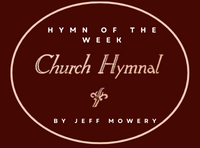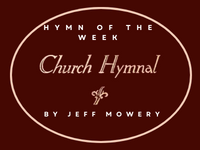O Sacred Head Now Wounded
“O sacred Head, now wounded, with grief and shame weighed down,
now scornfully surrounded with thorns, thine only crown:
how pale Thou art with anguish, with sore abuse and scorn!
How does that visage languish which once was bright as morn!
What thou, my Lord, has suffered was all for sinners’ gain;
Mine, Mine was the transgression, but Thine the deadly pain.
Lo, here I fall, my Savior! ‘Tis I deserve thy place;
look on me with Thy favor, vouchsafe to me thy grace.
What language shall I borrow to thank thee, dearest friend,
for this thy dying sorrow, thy pity without end?
O make me thine forever; and should I fainting be,
Lord, let me never, never outlive my love for thee.”
Since I am going to be on vacation next week, I thought I would send next week’s hymn before I go out of town.
This particular hymn was written about 800 years ago and is attributed to a French monk – Bernard of Clairvaux. It is part of a larger poem written about Christ’s body and the suffering of His feet, hands, side, breast, heart, face, and head. The three verses of this hymn were the final portion of that poem that became the hymn “O Sacred Head, now wounded.” The “O” in the title of this song connotes a reverance as the author recalls the crucifixation of our Lord. The first verse of this hymn paints a picture of the sorrowful scene of Christ as He suffered from the weight of our sin and the physical pain that He endured. The words of this verse provide a distinct contrast to some of the beautiful depictions of Christ we often see in paintings with words like grief, shame, scorn, anguish, abuse, and languish. I think it is important that we not “gloss” over the reality of the cross and Christ’s suffering, and the first verse of this hymn is an excellent reminder of that.
There is a phrase in the second verse that I wanted to highlight. In the second line, the author says “Mine, Mine, was the transgression, but Thine the deadly pain.” If you are around young children playing together, it won’t take long before you hear the phrase “Mine!! Mine!!” That “Mine” is a cry of selfishness rooted in sinfulness that all of us have because of our human nature. How different is the truth found in the meaning the author has in this verse. It is not a selfish “Mine! Mine!”, but an acceptance and a reminder that it was our sin, our transgressions, and our unholy living that He suffered and died for. We sinned. He suffered. We transgressed. He transformed us. We forsook Him. He forgave us. Isaiah 53:5 says “But he was wounded for our transgressions, he was bruised for our iniquities: the chastisement of our peace was upon him.”
In that same verse, the author makes the statement “Tis I deserve Thy place.” When looking at the Cross (especially when viewing a movie like the Passion of the Christ), we are horrified and humbled by what we know Jesus must have suffered on the cross. But do we really think that we deserve the kind of punishment that He bore on the cross? In our minds, it is easier to put a murderer on that kind of cross. Maybe even a thief, an adulterer, a child abuser, etc. But how about a liar, a gossip, a back-biter? Do we picture ourselves on that cross suffering for our own transgressions? In comparison to others, our sins might not seem that bad. However, in comparison to God and His holiness, our “righteousness is as filthy rags” according to Isaiah 64:6. Jesus taught us in the Sermon on the Mount that our sin is not necessarily based entirely upon our actions (whether we kill or commit adultery literally), but what is in our heart. We might put ourselves into one of those “big” sin categories if we truly had an understanding of what Jesus said in Matthew 5.
Finally, I realize that October may not be the time during the year when we typically reflect on the work of the Cross. However, there are some parallels. During the fall, leaves begin to change color and trees appear to “die.” I love the beauty found in the leaves this time of year, but when looking at that beauty we are also witnessing death in those leaves. We also know that several months from now we will see life again from the trees that appear to have died. With the Cross, we, as Christians, also see a beauty in His death. But, how much more than the beauty that will come in the spring is the truth of His resurrection that came that morning 2,000 years ago. His death, burial and resurrection are not only central to our theology, but should be central to our daily lives. This “sacred” hymn written a long time ago can still point us back to that place, and refocus our minds and thoughts on the truth found in 1 Timothy 1:15, “that Christ Jesus came into the world to save sinners; of whom I am chief.“

